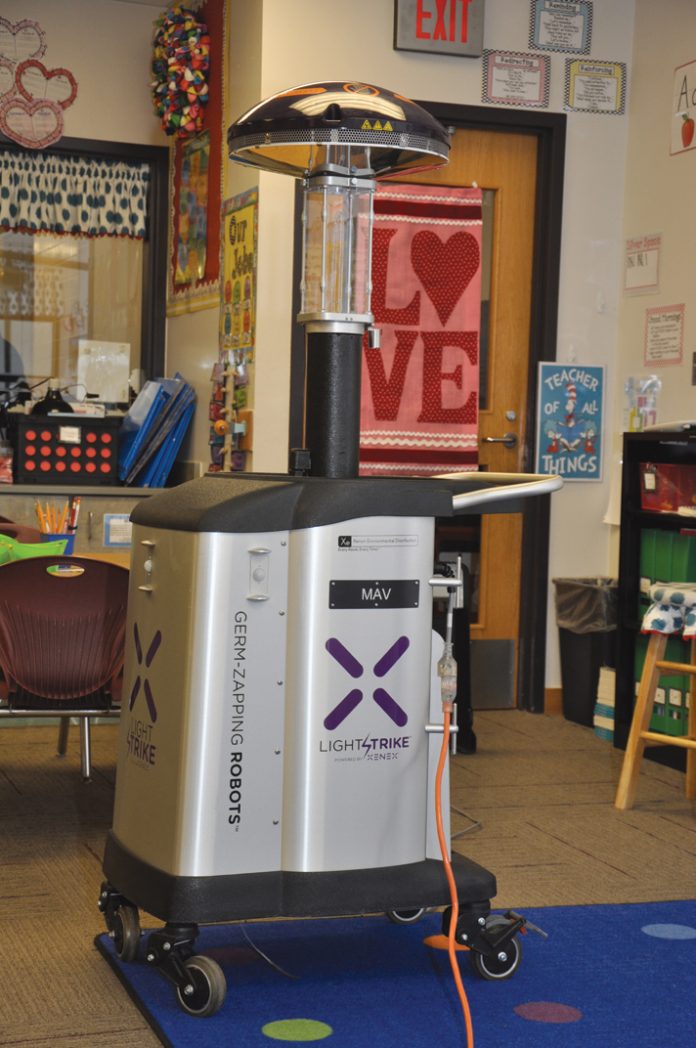
by Bobby Anderson
Staff Writer
Clyde Brawner has worked for Norman Regional Health System for 33 years now.
But the director of environmental services and distribution transportation has never seen his organization have the kind of impact in such a short period as it did recently.
“Our health system CEO (Richie Splitt) saw the rise of flu cases as something that we as a health system needed to involve ourselves with from a community outreach stance,” Brawner said.
While the flu was raving Cleveland County and the rest of Oklahoma, Splitt visited with the superintendents from Moore, Noble and Norman public schools to work out the logistics that would bring the same germ fighting technology Norman Regional employs in patient areas to the classroom.
All three districts were more than willing to invite the Xenex robots and Norman Regional employees into the schools.
Eleven germ-fighting robots descended upon central Oklahoma recently to fight germs including the flu virus in local schools.
The XENEX Lightstrike Germ-Zapping Robot is a UV disinfection robot.
The robot uses a pulsed xenon lamp to create intense germicidal ultraviolet light that effectively kills the germs that cause serious infections such as influenza, C. difficile, MRSA and more.
Xenex drop-shipped the robots at the school sites and Norman Regional healers followed behind.
“We have certified users within the health system,” Brawner explained. “We developed three teams composed of four to five employees along with school custodial workers. We trained the custodial workers on the use of the devices and the super users from the health system actually oversaw the teams as they went about disinfecting the classrooms.”
“What it does is disinfect by changing or distorting the DNA makeup so that organisms, viruses, germs or spores can not replicate,” Brawner said.
The machines look like R2D2 with the ability to emit UV light 10 times brighter than the surface of the sun.
Within the health system, Brawner explained the robots are used in the terminal clean process, disinfecting a 14-foot radius per cycle. Typically rooms are run in two or three five-minute cycles.
Feedback was impressive.
“Everybody was so thankful we partnered with them,” Brawner said.
Brawner learned that at one particular Norman school no new flu cases were reported the week of the Xenex cleaning.
“I was impressed when I heard that one,” he said. “I will tell you it really was a great opportunity to do that.”
For the past two years, Norman Regional Health System has used its four Lightstrike robots daily to enhance safety by disinfecting patient rooms and other hospital areas.
The health system has been impressed for the last two years utilizing the robots, reporting a 35-percent drop in healthcare acquired infections.
Richie Splitt, president and CEO of Norman Regional, said since the hospital had seen great results, it wanted to share the robots’ capabilities with the community.
“Norman Regional is committed to improving the health of our community, both inside and outside our hospital doors. If we could provide a robot in every classroom we would, but we’re doing the next best thing by sending 11 robots to our partners at local schools to fight the flu,” Splitt said. “As a healthcare provider, we’ve seen how illness can spread quickly and we know that children learn better when they are healthy. Through this partnership with XENEX and local schools we are helping to keep our kids, educators, and parents healthy.”
Norman Regional has expanded its Xenex use to elevators, restrooms, and clinics to help curb the virus.
Matt Crowe, Xenex territory manager, said Norman Regional’s request for extra robots was an easy one to fulfill.
“Norman Regional is dedicated to creating the safest environment possible and we are extremely proud to help them protect the communities that they serve,” Crowe said. “Xenex is the global leader in UV disinfection and our Germ-Zapping Robots are highly effective against the resistant pathogens that challenge our cities and our hospitals the most: C. difficile, MRSA, Norovirus and Influenza.
“Through our combined efforts this week, we are proactively making a safer environment for all of these students and teachers. Families in these school districts should be thankful to have a health system so dedicated to their well-being.”
After the week, the extra robots were returned to XENEX, but Norman Regional’s four permanent robots kept working throughout the system.
Norman Regional Health System Infection Prevention Specialist Julie Smith, RN, MS, CIC says hospital sites around the country have shown impressive declines in organisms by using the system including:
* 70% reduction in ICU C. diff infection rates
* 53% reduction in C. diff infection rates
* 57% reduction in MRSA infection rates
* 100% elimination of VRE in isolation rooms













